The historically rich and beloved city of India, Gwalior is one of the major tourist destinations of the country that captivates the hearts of people because of its beautiful and sunning architectural marvels that includes the forts and palaces. The memorable city is a part of the Indian State of Madhya Pradesh. Situated at a level of 196 meters above the sea level, Gwalior is considered to be under the administrative district of Gwalior. Another renowned world known for its extraordinary palaces, sacred temples and glorious monuments, Gwalior is located in the Grid Region of India.
Ruled by many empires, Gwalior is actually considered to be the city of true royals those are the Scindias. The land to the magnificent forts, Gwalior is very well known as the Fort City. Being the largest city of the central India, Gwalior is flanked by the large commercial and industrial zones. Yet it is the biggest tourist fascination of the state of Madhya Pradesh.
Holding a grand historic significance, Gwalior is amongst those five princely states that were honoured by the 21 Gun Salute during the rule of British. Considered to be amongst the biggest educational hub of the country, Gwalior houses the Scindia School which is located right inside the Gwalior Fort and is now considered to be one of the most crucial boarding school of the country.
The fourth largest city of the state of Madhya Pradesh, it is also called as the city of Music. It is told by the legends that the Tansen once visited Gwalior and thus Gwalior also houses the popular gharanas which is also known as the School of Hindustani Classical Music. It is believed that Gwalior was the final place where Tansen rested in last time period of his life. As Tansen was considered to be the amongst the nine gems that Mughal Emperor Akbar’s Court housed, Gwalior also houses the first museum that displays the musical instruments and is now known as the Sarod Ghar.
Regarded as the Heart of the Incredible India, Gwalior is one of the major tourist attractions of the country that fascinates people to explore it and the charm that it houses in its own self. With its extraordinary charm that it houses, Gwalior is a city which should be explored and uncovered in a lifetime.
Considered to be the historic city, Gwalior has its name on the pages of history from back in the ancient times. The researches and the cave paintings found in the area of Gwalior depicts the age of this magnificent city. Referred in the epic Mahabharata, the place called Gopalkaksh was the place where Bhima had his victory. Gopalkaksh was then also known as the Gopadri or Gopagiri which was the name with which Gwalior was known earlier. Later in the 2nd century, the city was taken under the influence of the Nagvans Clan. Later the capital of the Nagvans Dynasty was shifted from Vidisha to Padmavati (modern Pawaya) which is located as a distance of 68 kilometer from Gwalior.
As the Maharaja Suraj Sen founded the Gwalior Fort, later the city was a part of the empires of many different rulers. Naad Dynasty who ruled in the city Gwalior in the 6th century, Gwalior was then became the most crucial location for religious and cultural practices. Before the rule of the Naad Dynasty came into notice, it is believed that Gwalior by 3rd century was ruled by the Kushanas and later the rule was invaded by the Gupta Rulers in somewhat around 476 AD. Later in the city was ruled by the Kannauj of the Gurar Pratihara Dynasty in 5th Century and later in 7th century, Gwalior was regarded as the capital of Kannauj from 700 to 740 AD. During this time period, the Sun Temple in the Fort Hill was established which is now one of the biggest attraction of Gwalior.
While the history of Gwalior is been made up with the great rulers of different dynasties, Gwalior was later invaded by the Kachwaha Rulers who were the founder of another major attraction of Gwalior which is the Padavali Group of Monuments and also the Sahastrabahu Temple which again situated in the Gwalior Fort. Later between the time period of 1195 and 1196, the Muhammad of Ghor tried to invade the fort yet he couldn’t because of the brave rulers of Parihars were able to retain their kingdom with them. In 1231, it is said that the Gwalior was ruled by the Iltutmish and later Gwalior came under the rule of the Muslim Empire which lasted from 13th century till 1375. Later Gwalior was under the rule of the Raja Veer Singh who later discovered Tomars as a ruler of the Gwalior. During the ruler of the Tomars, the famous attractions of now were made that includes the magnificent Jain Temples and the most crucial tourist attraction of Gwalior of today, the Maan Mandir Palace which was initially constructed as the residence of the Maharaja Maan Singh.
This is the only palace which is known as to be the Pearl in the necklace of the Forts of the country.
In the 15th century, plenty of changes in the style of ruling occurred in Gwalior and the biggest event in the history took place when the Tansen visited Gwalior and the establishment of the music school was done. As it was ruled by both the Mughals and the Marathas, Gwalior’s final rulers were the Scindias. Later in the British ruler, Gwalior was regarded as the one of the five Princely States of India.
Being the witness to the plenty of the empires, Gwalior is one of the most historic cities and is considered to be one of the most beautiful cities one should explore.

Gwalior is a place that is very well connected with the wide network of roads in the state of Madhya Pradesh and also to Agra at a distance of 118 kilometres. Also it is connected to cities like Mathura, Jaipur, Delhi, Lucknow, Bhopal and Chanderi as well.
Gwalior is totally-packed with some of the most praiseworthy attractions; one can explore this central city any time of the year except for summers. It’s advisable to avoid travelling in the summers because the temperature rises up to 47 degree Celsius [it becomes quite hot and humid]. Commencing from the month of October to the end of March is dressed in the pleasant climatic conditions. Hence it’s considered as the best-suited duration of exploration.
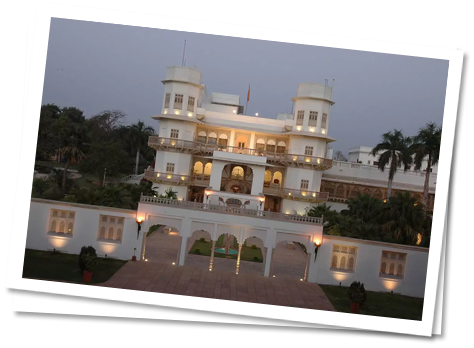
Since Gwalior is one of the most prominent tourist’s destinations of the country; Gwalior Hotels provides comfortable stay to the visitors and give them quality services that suit their budgets.
This enticing city of historic marvels resides under the greatness of various shopping destinations as well. As we all know that a trip is incomplete without shopping; Gwalior houses various markets, which offer basic necessities, ethnic stuff, home Décor to the fancy products etc. Here are the names of some chief markets that serve the demands of locals as well as the visitors :-
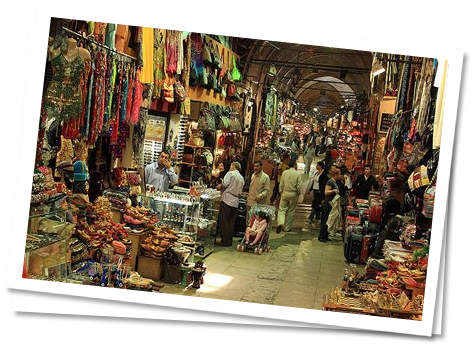
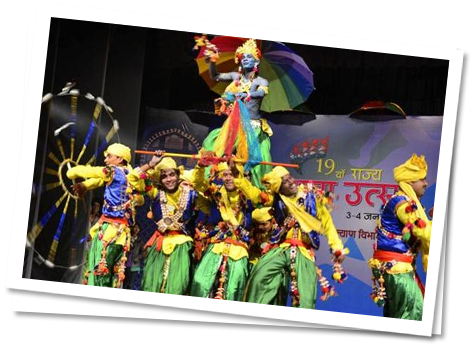
The eminent city of Madhya Pradesh is adorned with the layers of age-old running shades of art and literature; in fact, it holds a well-known position in the Indian classical music, literature and art. In the year 2005, in the month of August, an exceptional mural was created by Aasutosh Panigrahi and five other artists; that mural was acknowledged as the World’s Largest Indoor Mural by the Guinness World Records.
Under the bracket of cultural aspect, Gwalior is the confluence of two rich cultures – Braj and Bundeli. Gwalior has served as the birth land for numerous artistic stars [several writers and poets have grown up here]. This city is the also the birthplace of the oldest Hindustani Sangeet Gharana – the Gwalior Gharana. An exemplary festival named as the Tansen festival is one of the prime festive occasions in present in the state of Madhya Pradesh. Another prominence soaked occasion is the Gwalior trade fair, which resides for days under the influence of numerous attractions that make it livelier.
Gwalior is also a home to the Roop Singh stadium; it can accommodate the population figure of 45,000. This stadium has hosted several one day International Matches. When it comes to fooding, Gwalior is nowhere less; here are the names of some Samosa and Kachori| Jalebi and Rabdi| Morena Gajak etc.
Hindi is the most prevalent mode of communication [the widely spoken language]. And Marathi is the second most spoken language of communication because of the impactful influence of the Maratha rule in Gwalior over centuries.
The enticing city of Gwalior is home to a majority population of Hindus [88.84 per cent]. Other religions practised in this appealing city include Islam [8.58 per cent], Sikhism [0.56 per cent], Jainism [1.41 per cent] and Christianity [0.29 per cent].
The exceptional architecture and past-packed city of Gwalior is the pride destination of the central state of India [Madhya Pradesh]. The ethnic city and its fortress have been governed by various historic northern Indian Kingdoms – from the Kachchhapaghatas in the 10th century to the Scindia in the 18th century. The city of Gwalior is not only blessed with the phenomenal presence of the architectural marvels but it’s also home to a festival, which makes this city gifted with a unique identity - the Tansen Music festival.
It’s also addressed as the Tansen Samaroh; this festival of art is celebrated every year in the month of December in Behat village of the Gwalior district in the striking state of Madhya Pradesh. The Tansen Music Festival is a 4-day musical spectacle; this festive occasion pulls the presence of art and music admirers from every corner of the world so as to pay tribute to the Great Indian Musical Maestro Tansen.
This grand event is organized close to the tomb of Tansen by the Academy of the department of culture, Government of Madhya Pradesh. This event serves as a great opportunity for talented artists to come and deliver vocal and instrumental performances. The other occasion of importance is the Gwalior Trade Fair, which is a large fair organized in Madhya Pradesh. This exemplary fair was started by the King of Gwalior – Maharaj Madhav Rao Scindia in the year 1905. Some of the prime attractions of this fair are “Haasya Kavi Sammelan”, the cultural evenings, the “Kavvali Dangals, music nights etc.
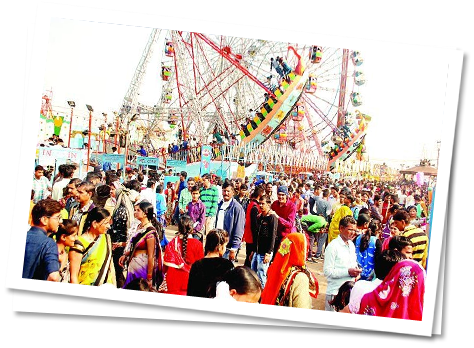
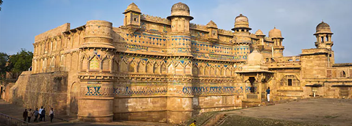
Gwalior Fort a stunning architectural marvel of the 8th century is a hill top fort which was established by the Maharaja Suraj Sen. Famous for its dazzling architecture, the fort houses two main palaces, various temples and few water tanks.
Initially built in the Dravidian style of architecture and the sculpted exteriors are a matter of great importance. Later in the 15th century the add on to the fort is the magnificent Man Singh palace that reflects the architectural styles of the Tomar Dynasty. Being the home to the plenty of other palaces, this magnificent Gwalior Fort is the biggest tourist attraction of Gwalior.
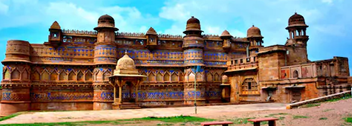
The most important tourist location is the Man Singh Palace which resides in the magnificent Gwalior Fort. Constructed by the Raja Man Singh of Tomar Dynasty in 1486 – 1516, he used the palace as his own residence. Later as the fort was invaded by other empires, the rulers changed and so does the residence authority of this palace changed. Built in the typical Hindu Architectural Style, the Man Singh Palace is a matter of great architectural design of building.
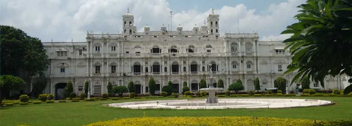
Initially a palace, the Jai Vilas Palace Museum was built in the 1784 by the Maharaja Jayaji Rao Scindia. Designed by the famous architect of that time, Sir Michael Filose, the palace is made up of perfect European Style and showcases different style of architecture in every single floor. The first floor showcases the Tuscan architecture style, the second floor showcases the Italian Doric style and the third floor showcases the Corinthian style of architecture. With a collection of largest pair of chandeliers in the world, Jai Vilas Palace, houses the silver carriage, Oil paintings by Raja Rabi Verma, Malabar Furniture, Crystal Furniture, Palki, Pooja Ghar, Jacobean Furniture, Napolean Table, Miniature Paintings, Lithograph, Old Royal Photograph, Silver Train, Chinese Pot, Jain Sculpture, Lord Vishnu Bronze Statue, Balgogal Bronze Statue and plenty of others.
Now, as it is converted into a museum, the museum exhibits the artefacts, antiquities of the 19th and 20th centuries.
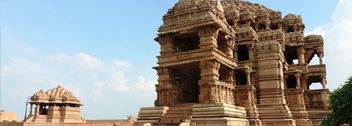
The well known temple of Gwalior is the Sas Bahu Temple dedicated to lord Vishnu by the King Mahipala. As lord Vishnu is known as the Sahastrabahu, the temple was named after his name but eventually because of misinterpretation or mispronunciation the temple was then called as the Sas Bahu temple. As the construction of the temple was completed in 1092 AD, the temple gate showcases a caption in Sanskrit language and the doorway provides the perfect view of the Indian Trinity, Lord Brahma who is the creator, Lord Vishnu who is the Preserver and the Lord Shiva who is the destroyer.
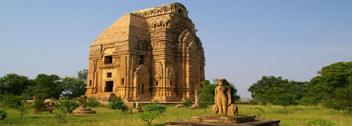
Another impressive and splendid temple of the Gwalior is this Teli ka Mandir which is situated in the Gwalior Fort and holds a great and importance historic significance. Built in a perfect fusion of the northern and southern style of architecture. As the fort is regarded as the ‘Pearl in the Necklace of the castles of Hind’, the Teli ka Mandir is situated right there. The temple was an ancient place of the Jain Worship and pilgrimage.
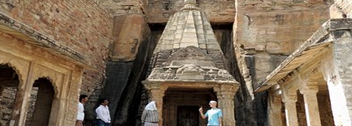
A rock cut temple built in the monolithic stone has its origin back from the 9th century and is situated in the magnificent Gwalior Fort; it has its roots on the eastern road to the fort. With many Sanskrit inscriptions an craved on he walls of the temple, the first recorded representation of zero is where it is written as a dot. As per the legends say, the temple was built by the grandson of Nagarabhatta in the year 875 AD.
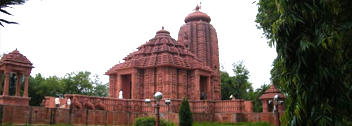
Another most important pilgrimage site of Gwalior is the Surya Mandir which is a temple dedicated to the Sun God and thus was built by the G.D Birla, who was the well known industrialist of India in 1988. The most recent construction in the city of Gwalior is the Surya Temple that houses extremely stunning structure of Lord Surya and is famous for its splendid architecture and the wall carvings. Built in the red sand stone, the temple’s interiors are built with the pure while marble.
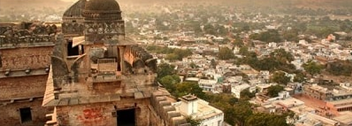
The small yet planned town of Madhya Pradesh is another big attraction of Gwalior. Known for its handloom sarees, Chanderi was considered to be the straddled the routes to Central India, Deccan, Malwa and other ports of Gujarat. With the major attraction as the Chanderi Fort which stands at a height of 71 meters, the fort was built in the period when Mughals had their rule in Gwalior. Also known the Kirti Drug, the Chanderi Fort is famous for its architecture and offers a splendid view of the city.
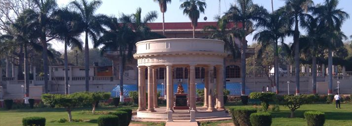
The extremely beautiful park of Gwalior was inaugurated by the Prince of Whales in 1922 when he visited the city of Gwalior. Situated near the vicinity to the railway station of the city, the Phool Bagh was built by the late Madho Rao Scindia and it houses a residential palace and a museum while the area and the campus of the park also houses the Gwalior Zoo, a temple, a mosque and a gurudwara.
While Gwalior is a city that holds a grand historic significance, as per the Gwalior point of interest, one can opt for a Gwalior Sightseeing Tour.
Copyright © 2020 Travelsite India All Right Reserved